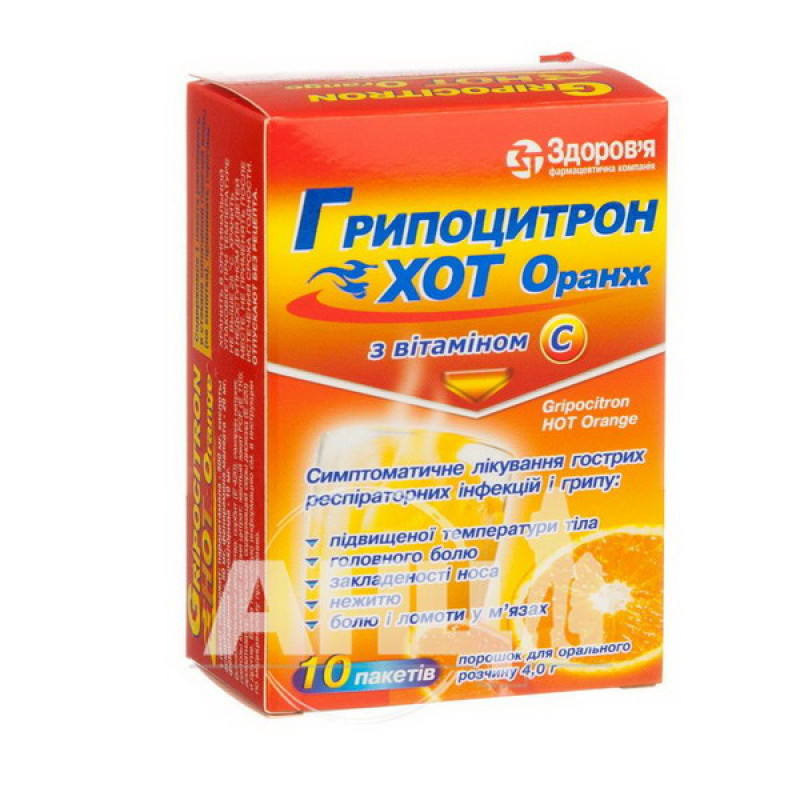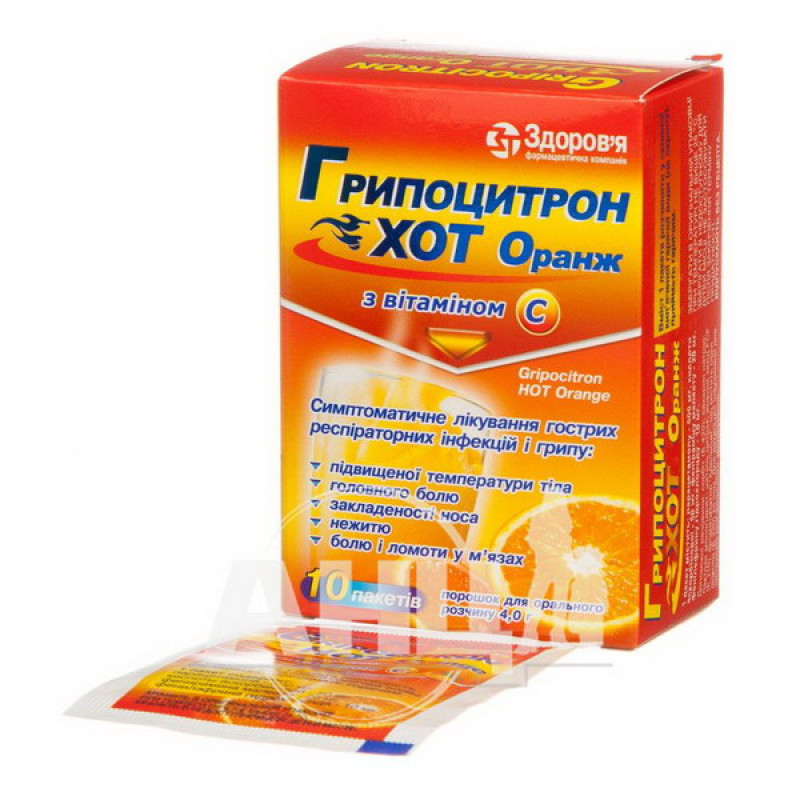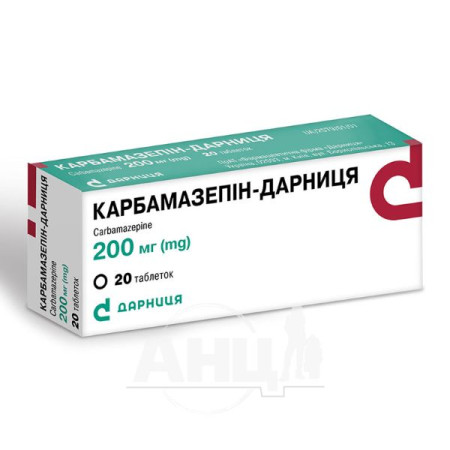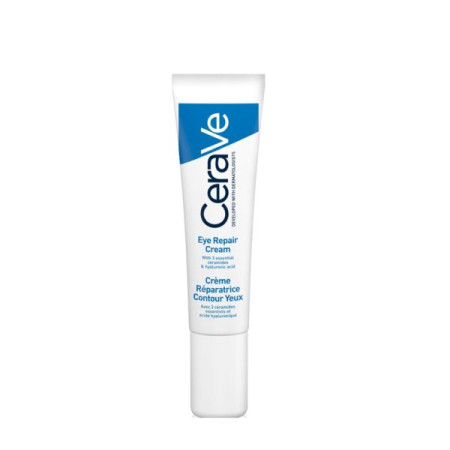Gripotsitron Hot Orange powder for oral solution, pack of 4 g, No. 10

Pharmacological properties
Antipyretic, analgesic, antihistamine, vasoconstrictor combined drug, the effect of which is due to the properties of the components that make up its composition.
Acetaminophen (paracetamol) has antipyretic, analgesic, and weak anti-inflammatory effects. Acetaminophen primarily inhibits prostaglandin synthesis in the CNS and has a lesser effect on the peripheral nervous system, blocking the conduction of pain impulses.
Pheniramine maleate is an antihistamine, a blocker of histamine H 1 receptors on effector cells, reduces vascular permeability, prevents the development of tissue edema, reduces the severity of local exudative processes, eliminates tearing, itching in the eye and nose area.
Phenylephrine hydrochloride is a sympathomimetic that stimulates α-adrenoreceptors to a greater extent, has a vasoconstrictor effect, and reduces swelling of the nasal mucosa and paranasal sinuses.
Ascorbic acid compensates for the increased need for vitamin C during respiratory infections and enhances the body's nonspecific resistance.
Acetaminophen is rapidly and almost completely absorbed from the gastrointestinal tract, crosses the placental barrier, and a small amount is excreted in breast milk. 95% of acetaminophen is metabolized in the liver by sulfo- and glucuronide conjugation, as well as oxidation by the cytochrome P450 system. T ½ is 1-4 hours. C max - 3-4 hours. Excreted by the kidneys, mainly in the form of metabolites, 3% of the drug is excreted unchanged.
Pheniramine maleate is well absorbed after oral administration. Biotransformation occurs in the liver by oxidation by the cytochrome P450 system, T ½ is 16-18 hours after oral administration. 70-83% is excreted by the kidneys in unchanged form and in the form of metabolites.
The effect of phenylephrine hydrochloride occurs quickly after application and lasts approximately 20 minutes. Biotransformation occurs in the liver or gastrointestinal tract. It is excreted by the kidneys.
Ascorbic acid is rapidly absorbed in the gastrointestinal tract. The level of binding to plasma proteins is low. It accumulates in blood plasma and cells, the highest concentration is noted in glandular tissues. Biotransformation occurs in the liver. It is excreted in the form of metabolites and unchanged by the kidneys.
Indication
Symptomatic treatment of infectious and inflammatory diseases (flu, acute respiratory viral infections, colds) accompanied by elevated body temperature, chills, headache, runny nose, swelling of the nasal mucosa (rhinitis), sneezing and muscle pain (ache), as well as allergic rhinitis, rhinopharyngitis, is also used to increase the effectiveness of the body's immune defense.
Application
Use internally. Before use, dissolve the contents of 1 packet in a glass of boiled hot water (not boiling water);
GRIPPOCITRON HOT LEMON; GRIPPOCITRON HOT ORANGE; GRIPPOCITRON FORTE.
Inside adults and children aged 12 years (Grippocitron Hot Lemon) and 14 years (Gippocitron Froth) 1 sachet every 4-6 hours, but not more than 3 sachets per day. Take warm. Duration of treatment - up to 5 days.
GRIPPOCITRON KIDS LEMON; GRIPPOCITRON KIDS ORANGE.
A single dose for children aged 2-5 years is the contents of 1 packet, for children aged 6-12 years is the contents of 2 packets. If necessary, repeat the dose every 4-6 hours, but not more than 4 packets per day. The total duration of treatment should not exceed 5 days. Further use is possible only under the supervision of a doctor.
Contraindication
Hypersensitivity to the components of the drug, severe hepatic and/or renal failure, glucose-6-phosphate dehydrogenase deficiency, glaucoma, epilepsy, blood diseases, pyloroduodenal obstruction, bladder neck obstruction.
GRIPPOCITRON HOT LEMON; GRIPPOCITRON HOT ORANGE; GRIPPOCITRON FORTE.
Severe cardiovascular diseases, severe hypertension, ventricular tachycardia, prostate adenoma with difficulty urinating, stenosing gastric and duodenal ulcers, lung diseases (including bronchial asthma), predisposition to angiospasm. Pregnancy and breastfeeding.
GRIPPOCITRON KIDS LEMON; GRIPPOCITRON KIDS ORANGE.
The drug is contraindicated in the following cases:
Gilbert's syndrome (intermittent benign jaundice resulting from glucuronyltransferase deficiency); severe cardiac conduction disorders; uncompensated heart failure; hyperthyroidism; fructose intolerance; glucose-galactose malabsorption syndrome; thrombosis; thrombophlebitis; tendency to thrombosis; severe hyperbilirubinemia; Dubin-Johnson syndrome; hematopoietic disorders; severe leukopenia; anemia; gastric and duodenal ulcer in the acute stage; age up to 2 years.Do not use with MAO inhibitors and within 2 weeks after discontinuing MAO inhibitors.
Side effects
Grippocitron hot lemon; Grippocitron hot orange; Grippocitron forte.
Possible: drowsiness, dizziness, dry mouth or throat, fatigue, headache, insomnia, irritability or nervousness, tachycardia and palpitations, allergic reactions (skin rash, itching, urticaria); rarely (mainly in children) - agitation and sleep disturbances.
Adverse reactions associated with the action of paracetamol: allergic reactions: rarely - urticaria, itching, skin rash, rash on the mucous membranes, angioedema, exudative erythema multiforme (including Stevens-Johnson syndrome), toxic epidermal necrolysis (Lyell's syndrome).
From the side of the central nervous system: psychomotor agitation and disorientation (usually develops when taken in high doses).
On the part of the gastrointestinal tract: rarely - pain in the epigastric region, nausea, increased activity of liver enzymes, usually without the development of jaundice, hepatonecrosis (dose-dependent effect); with prolonged use, especially in high doses, a hepatotoxic effect is possible.
From the side of the hematopoietic system: rarely - thrombocytopenia, leukopenia, neutropenia; in isolated cases - agranulocytosis; with prolonged use, especially in high doses, anemia (hemolytic and aplastic), pancytopenia, methemoglobinemia, sulfhemoglobinemia are possible.
On the part of the urinary system: with prolonged use, especially in high doses, nephrotoxic effects are possible (including renal colic, interstitial nephritis, capillary necrosis).
Other: rarely - a decrease in blood pressure; in patients with intolerance to acetylsalicylic acid (with asthma) sometimes - hypersensitivity reactions.
Adverse reactions associated with the sympathomimetic action of phenylephrine: a slight increase in blood pressure (especially in patients with hypertension), reflex bradycardia, mydriasis; urinary retention and difficulty urinating; possible effects on the endocrine and other systems involved in metabolism.
Adverse reactions associated with the peripheral anticholinergic effects of pheniramine: dry mouth, dry eye mucosa, urinary retention, difficulty urinating in men.
Side effects associated with the central effects of pheniramine: drowsiness, in rare cases - coma, epileptic seizures, dyskinesia, behavioral changes. In the event of any unusual reactions, you should definitely consult a doctor regarding further use of the drug.
GRIPPOCITRON KIDS LEMON; GRIPPOCITRON KIDS ORANGE
The following undesirable effects have been noted after prolonged use in amounts exceeding the recommended daily doses:
from the blood and lymphatic system - anemia, sulfhemoglobinemia and methemoglobinemia (cyanosis, shortness of breath, pain in the heart area), hemolytic anemia (if the patient has glucose-6-phosphate dehydrogenase deficiency), thrombocytopenia, thrombocytosis, hyperprothrombinemia, erythrocytopenia, neutrophilic leukocytosis, bronchospasm in patients sensitive to acetylsalicylic acid and other nonsteroidal anti-inflammatory drugs;
from the gastrointestinal tract - nausea, vomiting, dry mouth, discomfort and pain in the epigastric region, hypersalivation, decreased appetite, heartburn, diarrhea, impaired liver function, hypoglycemia up to hypoglycemic coma, damage to the insular apparatus of the pancreas (hyperglycemia, glucosuria) and impaired glycogen synthesis up to the development of diabetes mellitus;
on the part of the hepatobiliary system - increased activity of liver enzymes, usually without the development of jaundice, hepatonecrosis (dose-dependent effect);
from the immune system - anaphylaxis, hypersensitivity reactions;
from the nervous system - headache, dizziness, psychomotor agitation and disorientation, anxiety, feeling of fear, sleep disturbances, drowsiness, insomnia, confusion, in some cases - coma, convulsions, dyskinesia, behavioral changes;
from the cardiovascular system - tachycardia, reflex bradycardia, shortness of breath, heart pain, increased blood pressure, arrhythmia, myocardial dystrophy (dose-dependent effect with prolonged use);
from the kidneys and urinary tract - renal colic and interstitial nephritis, urinary retention and difficulty urinating, aseptic pyuria, with prolonged use in high doses: damage to the glomerular apparatus of the kidneys, crystalluria, formation of urate, cystine and / or oxalate stones in the kidneys and urinary tract;
from the visual analyzer - impaired vision and accommodation, dry eyes, mydriasis;
from the skin and subcutaneous tissues - itching, rashes on the skin and mucous membranes (erythema, urticaria), angioedema, erythema multiforme (including Stevens-Johnson syndrome), toxic epidermal necrolysis (Lyell's syndrome);
general: disorders of zinc and copper metabolism.
Special instructions
Children: Grippocitron Hot Lemon, Grippocitron Hot Orange - not for use in children under 12 years of age. Grippocitron Forte - not for use in children under 14 years of age. Grippocitron Kids Lemon; Grippocitron Kids Orange - used in children aged 2 to 12 years.
Ability to influence the reaction rate when driving vehicles or working with other mechanisms. When using the drug, it is not recommended to drive vehicles and work with complex mechanisms, as it can cause drowsiness. Children should be protected from activities that require increased concentration of attention for 4 hours after using the drug. GRIPPOCITRON HOT LEMON; GRIPPOCITRON HOT ORANGE; GRIPPOCITRON FORTE.
The drug contains lactose, therefore patients with rare hereditary forms of galactose intolerance, lactase deficiency or glucose-galactose malabsorption syndrome should not use the drug.
Only a doctor decides whether to take the drug in the following cases:
for hypertension, heart and thyroid diseases, asthma and other chronic lung diseases, prostatic hypertrophy; for chronic liver and kidney diseases; for chronic alcoholism.If symptoms of the disease persist for more than 5 days after taking the drug, treatment should be discontinued and a doctor should be consulted regarding the appropriateness of further use of the drug and additional examination.
Do not exceed the dose specified in the instructions, and do not use the drug if the package packaging is damaged.
Use during pregnancy and breastfeeding. The drug is contraindicated during pregnancy. If necessary, use of the drug should be discontinued.
Concomitant use with other drugs intended for the symptomatic treatment of colds and flu and drugs containing paracetamol should be avoided. Concomitant use with sedatives or hypnotics is not recommended.
The medicine should be prescribed by a doctor only after assessing the risk/benefit ratio in the following cases:
AH; epilepsy; oxaluria; urination disorders.If, on the recommendation of a doctor, the drug is used for a long period, it is necessary to monitor the functional state of the liver and the peripheral blood picture.
It is necessary to consult a doctor about the possibility of use in patients with impaired kidney and liver function. Simultaneous administration of the drug with alkaline drinks reduces the absorption of ascorbic acid, so you should not drink it with alkaline mineral water. Also, the absorption of ascorbic acid may be impaired in intestinal dyskinesia, enteritis and achilia.
Interactions
In case of using any other medicines, it is necessary to consult a doctor about the possibility of using the drug. The drug enhances the effects of MAO inhibitors, sedatives, ethanol. Simultaneous administration with MAO or earlier than 2 weeks after stopping their use is not recommended. The drug reduces the hypotensive effect of guanethidine, which, in turn, enhances the α-adrenostimulating activity of phenylephrine. The risk of hepatotoxic effects of the drug increases with simultaneous use of barbiturates, tricyclic antidepressants, rifampicin, isoniazid, as well as with alcohol. Simultaneous use with corticosteroids increases the risk of glaucoma in genetically predisposed patients, with nonsteroidal anti-inflammatory drugs - the risk of adverse reactions.
Antidepressants, antiparkinsonian and antipsychotic drugs, phenothiazine derivatives increase the risk of urinary retention, constipation, dry mouth. Long-term use of anticonvulsants may reduce the effectiveness of paracetamol. Paracetamol from the urinary system reduces the effectiveness of uricosuric drugs, enhances the effect of indirect anticoagulants, prolongs T ½ of chloramphenicol. Paracetamol and probenecid together affect metabolism. Phenylephrine may cause adverse reactions of interaction with MAO inhibitors, α- and β-adrenergic blockers, antihistamines, phenothiazine derivatives (promethazine), bronchodilator sympathomimetic agents, tricyclic antidepressants (imipramine), guanethidine or atropine, digitalis preparations, rauwolfia alkaloids, indomethacin, methyldopa, other agents that stimulate the central nervous system, and theophylline. In isolated cases, an increase in the vasoconstrictor effect was noted when used simultaneously with labor stimulants and arrhythmias - when used with anesthetics. A significant increase in blood pressure is possible with simultaneous intravenous administration of ergot alkaloids. Pheniramine enhances the effect of drugs that depress the central nervous system (MAO inhibitors, tricyclic antidepressants, antiparkinsonian drugs, barbiturates, tranquilizers, narcotics), as well as alcohol. Pheniramine can inhibit the effect of anticoagulants and interact with progesterone, reserpine, thiazide diuretics. Simultaneous use of oral contraceptives can lead to a decrease in the effectiveness of the antihistamine component. Ethanol enhances the sedative effect of pheniramine. Tricyclic antidepressants enhance the sympathomimetic effect of the drug, simultaneous administration of halothane increases the risk of ventricular arrhythmia.
Overdose
Symptoms of paracetamol overdose: pale skin, decreased appetite, nausea, vomiting; hepatotoxic effect, in severe cases, liver necrosis develops (the severity of necrosis as a result of intoxication directly depends on the degree of overdose). The first symptoms of hepatotoxic effects may appear within 24-48 hours or later after an overdose and include: nausea, vomiting, epigastric pain. A detailed clinical picture of liver damage is noted after 1-6 days. High doses of paracetamol (10-15 g) can cause the development of liver failure. Rarely, liver failure develops rapidly and may be complicated by renal failure (tubular necrosis).
Symptoms of phenylephrine overdose: drowsiness, followed by possible agitation (especially in children), visual disturbances, nausea, vomiting, headache, circulatory disorders, coma, convulsions, behavioral changes, increased blood pressure, bradycardia, atropine-like syndrome.
Treatment. Drug withdrawal, gastric lavage, activated charcoal. In severe cases, oral or intravenous administration of N-acetylcysteine as an antidote to paracetamol, monitoring of the respiratory and circulatory systems (adrenaline should not be used). In case of convulsions, diazepam is prescribed.
Storage conditions
At a temperature not exceeding 25 °C.
There are no reviews for this product.
There are no reviews for this product, be the first to leave your review.
No questions about this product, be the first and ask your question.
















